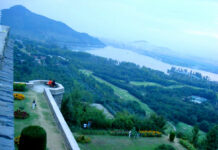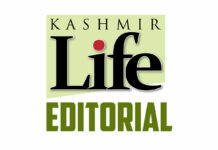One of India’s most respected editors, Shekhar Gupta was honest in admitting the fact that Delhi media looks at Kashmir more as a security issue rather than a place and a population. As head of a major newspaper in Delhi, his tenure has been very encouraging in accommodating issues that Kashmir confronted beyond the routine security drill. This trend helped other publications to toe the line, in at least using part of the stuff that Kashmir generates daily in contrast to the official narrative.
Gupta also made two important observations. Firstly, the journalism that has been routinely bridging the information gap between Kashmir and the mainland India has impacted the thought process of the non-local readership. Secondly, Kashmir does not require journalists being parachuted to report. He also revealed the already-known secret that accommodating Kashmir liberally is upsetting the security setup and he as editor has faced that adverse response.
Gupta made these revelations while releasing another edition of the writings of the politician-journalist Shamim Ahmad Shamim on his death anniversary.
Gupta’s observations are important because Kashmir press corps has survived almost miraculously because of two major perpetual tensions. Firstly, the conflicting forces in Kashmir were always trying to sandwich media for most of the initial years of militancy. Secondly, the security grid continuously used Delhi media to demonize Srinagar press corps. The worst instance was when a former editor condemned the media for reporting the mass rapes in Kupwara and made a very serious bid to dent its credibility.
So when journalists started falling in the line of duty in Srinagar, the propaganda unleashed against them left them isolated from the larger media fraternity that exists across borders and cultures. They reported their conflict and fought against the propaganda too.
Last time when a Kashmiri journalist in Delhi was framed in a case of espionage, the most shocking part of the crisis that his defence faced was when sections in the media turned against him. This did not help them hang the journalist but it only delayed him getting justice.
There might be changes at certain levels, but the ground level still retains the status quo ante: people of Kashmir fall next to the security of the place because it is linked to territorial integrity of the state. It still needs a lot of effort for a Srinagar reporter to get his copy pushed to the best slot, an effort usually their counter-parts in North East and Central India may not require at all.
The visual medium has added to the mess. Now anchors facing camera’s in ivory towers create storms in cups of tea on basis of the streaming images that a lens records. Sometimes the larger realities are missed as they are off the focus. The power of visual medium has started impacting the print coverage that usually ends up reacting to what the TV screens show. Some TV screens are now being watched in Kashmir as the official position of the issues confronting ground zero.
What makes Gupta’s assertions vital is that he talked about a particular time-space matrix in which Kashmir passed through an overwhelming situation. Sometimes, the whole existence of survival seemed doubtful. But his revelations are in continuation with admissions having been made already. One of his colleagues earlier had authored a book detailing the errors and tragedies triggered by the editorializing and changing the Kashmir reportage even in peaceful era when there were no guns, murders and attacks. This continuation vindicates the pessimists in Srinagar that Kashmir coverage in mainland media will retain the context and sub-text that has evolved with the security doctrine of the place. Even Gupta said truth is not against the national interest.









